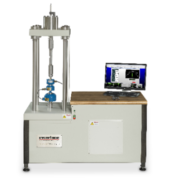Interface Measurement Solutions for the Natural Resources Industry
 Interface offers various sensor technologies for research, development, extracting, processing, and preserving natural resources. Our load cells and instrumentation are critical in measuring and monitoring forces, loads, and weight in different processes, equipment, tools, and technologies used in the natural resources industry. The data acquired from Interface load cells provides tremendous value in innovation, R&D, and optimization.
Interface offers various sensor technologies for research, development, extracting, processing, and preserving natural resources. Our load cells and instrumentation are critical in measuring and monitoring forces, loads, and weight in different processes, equipment, tools, and technologies used in the natural resources industry. The data acquired from Interface load cells provides tremendous value in innovation, R&D, and optimization.
Our load cells, torque transducers, multi-axis sensors, wireless telemetry systems, and instrumentation assist scientists, engineers, and researchers to accurately measure resource utilization, environmental impacts, and efficiencies in resource management. Our measurement solutions are used in the early stages of machine and tool designs to onsite monitoring equipment used in extraction processes, lifting, moving, and transporting materials.
As detailed below, our load cells and torque transducers are essential for the natural resources industry. They help to improve the efficiency, safety, and sustainability of natural resource extraction and processing.
Natural Resources Industry Use Cases for Interface Measurement Solutions
- Resource Innovation: Sensor technologies are utilized in R&D, identifying innovative ways to improve natural resource extraction, processing efficiency, and safety.
- Sample and Material Testing: Sensor devices measure and monitor the forces and loads on samples and materials during testing. These tools are required to research and develop new natural resource extraction and processing technologies.
- Mining and Quarrying Equipment Design and Testing: Load cells and torque transducers can measure and monitor forces, loads, and weight in mining and quarrying equipment, such as excavators, loaders, and crushers.
- Logging and Forestry Machine Regulatory and Safety Monitoring: Load cells can monitor the forces and loads on logging and forestry machines, such as harvesters and forwarders.
- Ground Stability Monitoring: Interface sensors can monitor ground stability in mines, quarries, and construction sites. This data can be used to identify and predict potential ground movements and to take steps to mitigate the risks.
- Drilling Optimization: Interface specialized load cells often measure and monitor the forces and loads on drilling rigs. This data can optimize the drilling process by adjusting the weight on the bit and the penetration rate.
- Material Handling: Load cells are valuable for weighing materials of all types.
- Pipeline Integrity Operations: Force measurement solutions can be used to monitor the pipeline’s integrity by identifying and predicting potential pipeline failures and taking steps to mitigate the risks. They are also utilized for measuring the flow of oil and gas.
- Soil Preparation and Agrarian Management Devices: Load cells and torque transducers can measure and monitor the forces and loads on soil preparation and agrarian management devices, such as tractors and harvesters.
- Water Resource Management: Interface transducers can monitor river, stream, and canal water flow. This data can be used to manage water resources effectively and to predict flooding risks.
- Timber Harvesting and Weighing Machinery: Interface measurement devices can measure and monitor the weight of harvested timber to ensure that wood is being harvested sustainably and to comply with regulations.
- Dam Safety: Load cells, such as load pins, can be used to monitor the structural integrity of dams. The force measurement sensor is also used to monitor the stability of other structures related to resource management.
- Mineral Processing Tools and Machines: Load cells and torque transducers can measure and monitor the forces and loads on mineral processing tools and machines, such as crushers, grinders, and conveyors. They are frequently used in designing vehicles and equipment, specifically in weight optimization.
Timber Weighing And Harvesting Solution
A timber company needs a weighing system for sustainable forest management. They need to measure the amount of timber harvested. Weighing and monitoring harvested timber helps with resource monitoring and contributes to the overall sustainability of the forestry industry. Interface suggests creating a truck weighing scale to weigh logging trucks before and after loading timber. Multiple SSLP Stainless Steel LowProfile Universal Load Cells with WTS-BS-1E Wireless Transmitter Modules are installed under the weighing bridge. The load cells will transmit the force results wirelessly to the WTS-BS-4 Industrial Base Station connected to the customer’s PC with the provided Log100 software. The WTS-LD2 Wireless Large LED Display can also display the weight inside for the driver to see in real-time. Results can also be viewed on the WTS-BS-1-HA Wireless Handheld Display for Multiple Transmitters.
Geothermal Well Drilling Optimization
Geothermal energy is the heat derived from the Earth’s interior, harnessed for various applications such as electricity generation and heating by utilizing the natural heat reservoirs found beneath the Earth’s surface. A customer had a conventional geothermal system and needed to drill a deep well into the Earth to tap into its natural heat reservoirs. Interface’s IPCD Pressure Compensated Downhole Load Cell is a highly accurate load cell explicitly developed for downhole tension and compression measurements in high temperature, high pressure well conditions, such as drilling to build or establish geothermal infrastructure. Precise tool string force measurements can be monitored through customer instrumentation. Using this sensor solution, the customer effectively managed forces on the tool string throughout the well-drilling process, preventing costly tool separation or damage.
NaturalResources_InfographicPosterFrom enhancing water management to precisely weighing timber for transportation, force sensors significantly mitigate risks, reduce environmental effects, and create safe work environments. As the natural resources industry grows and evolves, integrating force sensors is central to balancing resource utilization with ecological conservation and safety.








